
A lot more goes into the building of each Vs. System set than simply choosing a team, throwing characters into a pot, and testing to exhaustion (no pun intended). The lead designer of each set has a lot on his plate besides game mechanics, Sealed Pack play, and set interaction—he has to ensure that the set makes sense in terms of continuity, that the characters are true to their roots, and that there aren’t any inconsistencies when selecting characters, choosing versions, and naming cards.
Although the design team works hard to ensure that the game always has a comic book feel to it, they must often rely on outside people to help when it comes to making the set as appealing as possible to comic book fans. I’m fortunate enough to be one of those outside contractors; while I don’t have any part in the actual design of the cards, I spend hours compiling research, helping with the character selection and card naming, writing some of the flavor text, and assembling descriptions for the artwork. In short, while the design team works with the Lead Designer to make sure game play stays balanced and strong, I—and several colleagues such as the hard-working Billy Zonos—help him fill the sets with fun, flavor, and continuity, translating the designers’ ideas into great images for the cards.
JLA: The First Pass
The first step in the “other” design work is the research and set lists. The Lead Designer makes all of the final decisions regarding who makes what team, what names are used, and so forth, but with so much on his plate, he can’t spend an inordinate amount of time brainstorming cool names for plot twists . Enter the researchers: a hardy team who use a prescribed, everflowing fountain of comic book knowledge (and a steady supply of issues!) to help with the process.
Every designer has different needs. When I worked with Matt Hyra on JLA, he had the set pretty much figured out, so my research consisted of helping him to finalize the team rosters, provide several names for plot twists, add some ideas for locations and equipment, and designate which characters had flight and range. For this research, I dug into my JLA collection, including the three volumes of Crisis on Multiple Earths TPBs, the New World Order storyline, the entire run of JLA Detroit (in the 80’s Justice League of America), the entire run of Justice League/International/Europe/Task Force, the JLA/Avengers mini-series, the Identity Crisis mini-series, and as many Secret Society and Injustice Gang-related stories as I could find. I scoured the DC Encyclopedia and a half-dozen reliable internet sites for background information, and delved into my trusty Who’s Who in the DC Universe (both the original series and the 1987 update) for important details. As fun as it can be, it’s still a heckuva lot of reading. Don’t fool yourself into thinking that it’s not work—we have to spend long hours checking and double-checking facts and characters to make sure the sets are consistent with the comics.
The original character list had some interesting choices, some of which didn’t make it into the final set. JLA initially included characters like Triumph, Kendra Saunders and Carter Hall (who would later be switched to Shayera Thal and Katar Hol), a second version of Plastic Man, and another Big Barda.
The first part of finalizing the rosters is to decide which characters need to be represented and which are extraneous. Now, every character is “important” in terms of flavor and continuity—and each character is somebody’s favorite—so there is no truly expendable character. But at the same time, we need to ensure that every character on each team represents the theme of the set as best as possible, as well as taking past sets into account.
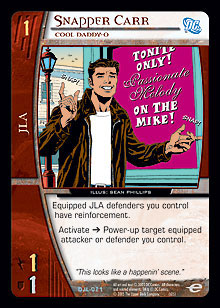 In the first pass, Triumph and Snapper Carr seemed expendable, in order to leave room for characters that were more integral to JLA history. Some examples of characters that were left off of the initial roster were the Phantom Stranger, the JLA Detroit team (Steel II, Vibe, Vixen and Gypsy), and post Zero-Hour JLA members Nuklon and Obsidian. Each of these characters helped to represent an era in JLA history that seemed lacking in that roster. If there was room, the Wonder Twins needed to be added as well—for pure nostalgic fun if nothing else!
In the first pass, Triumph and Snapper Carr seemed expendable, in order to leave room for characters that were more integral to JLA history. Some examples of characters that were left off of the initial roster were the Phantom Stranger, the JLA Detroit team (Steel II, Vibe, Vixen and Gypsy), and post Zero-Hour JLA members Nuklon and Obsidian. Each of these characters helped to represent an era in JLA history that seemed lacking in that roster. If there was room, the Wonder Twins needed to be added as well—for pure nostalgic fun if nothing else!
This was the very first step in a long process of culling and configuring a large list of potential characters into a well-rounded and viable final roster. At that point, when a researcher made suggestions, he or she spoke from the standpoint of comic history and continuity—the Lead Designer also had to consider thematic content, design considerations (such as a well-rounded curve and keyword/effect balance), and future set considerations which includes information that the researchers don’t always have available to them. The process has a changed a little bit now, where a team of researchers specifically considers drops, team affiliations, powers, and abilities when putting together potential rosters for teams.
Of those initial suggestions, only Gypsy ended up making the final cut – though you can see Steel II on the Secret Sanctuary location, along with Elongated Man and Zatanna in her 80’s costume. But character considerations were only half of my research work for that first pass—I also had to come up with several ideas for potential location and plot twist names. Some of the JLA card names on that first pass made it into the set—such as Rallying Cry!, Roll Call!, Magnificent Seven, Teleport Tube, Hero’s Welcome, Justice League Task Force, Running Interference, Gang-Up (which was originally “Ganging Up”), Criminal Mastermind, and Power Siphon. At least twice as many suggestions never made it to the next phase.
Of these name ideas, all were recommended as names for potential team-stamped cards, though several became generics at a later date. Card names tend to get shifted back and forth between teams and generics, depending on how they fit in terms of flavor and the overall needs of the set. Researchers can only put forth suggestions for names, and then only with an explanation as to where it comes from and why it makes sense as a card name. Whether or not those names are accepted or altered is completely beyond our control, and we never know which, if any, of our suggestions will be accepted or rejected.
Coming up with card names is not difficult. Coming up with interesting card names is a much harder task. It takes more than knowledge of comics. One needs a creative mind, a good eye, and a good memory.
Creativity is required to come up with catchy names: some great card names from past sets are Get Him My Petsss which is one of Danny Mandel’s best, and Reign of Terra. The former is great not only for the cheesy but cool-sounding name, but because it so handily reflects the essence of the Lizard. The latter is a great name because it takes a vital moment in the history of the Teen Titans (and Deathstroke), and incorporates game history into it as well. Reign of Terra is a double entendre, punning the Marvel Origins card, Reign of Terror, and also the storyline where Terra betrays the Titans in a plot masterminded by Deathstroke. Other examples of creativity include using terminology from outside sources that still make sense in terms of the card itself—like Fizzle, and I Hate Magic!. The former stems from a point very early in the game’s history when people referred to effect negation as “fizzling” and were frequently reminded that the term “Fizzle” didn’t exist in Vs. It does now, as a card that negates effects—oh the irony! The latter is intended as a good-hearted satire, which brilliantly reflects Superman’s weakness or vulnerability to magic.
The second characteristic needed is a good eye. During the research period, a lot of ideas come from reading the comics: bits of dialogue (including generic names like Not So Fast and specific ones like No Evil Shall Escape Our Sight or No Man Escapes the Manhunters, titles or synopses of storylines such as Project Utopia or A Day Unlike Any Other, names that come from character references like The Demon’s Head or Judge, Jury, and Executioner) and so on).
And the good memory helps you to dredge up ideas from comics you’ve read in the past, or that reflect the overall flavor of the teams or characters for the set you’re working on.
In addition, you always have to keep the needs of the set in mind. The roster that Matt sent me originally had some placeholders for cards (generic names that are used until proper names can be found), which included the likes of “Generic Search Card,” “Deck Thinner,” and the like. These would become Secret Origins, Crisis on Infinite Earths, Balance of Power, and Funeral for a Friend (which was originally named “Superman’s Funeral” and was changed in the later passes). While the card names often end up on a completely different type of card than the placeholder that sparked the idea (Crisis on Infinite Earths was the card name for “Deck Thinner”) others, like Secret Origins for “Search Card,” will remain in place even through to the final set.
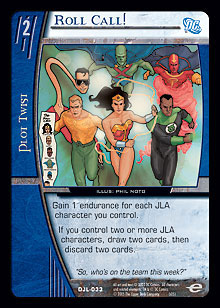 Most of the names in the first pass came from memory, some from reading or researching the comics. At this point, the research for the set lists had just begun, and art lists were still being assembled, so more names would come up as I dug deeper into the stories. Many titles arose naturally from the words and images of the comics. For example, Roll Call! was a good name for a JLA search or team-up card because every JLA comic in the “olden days” had a “Roll Call!” on the opening splash page featuring that issue’s lineup (just like the art on the card).
Most of the names in the first pass came from memory, some from reading or researching the comics. At this point, the research for the set lists had just begun, and art lists were still being assembled, so more names would come up as I dug deeper into the stories. Many titles arose naturally from the words and images of the comics. For example, Roll Call! was a good name for a JLA search or team-up card because every JLA comic in the “olden days” had a “Roll Call!” on the opening splash page featuring that issue’s lineup (just like the art on the card).
Hero’s Welcome came from the parades and positive response that DC’s heroes receive in their universe (as opposed to the fear and distrust that often greet heroes in the Marvel universe). The JLA/Avengers mini-series really highlighted that difference, and I thought it would be interesting to include it in a card.
Justice League Task Force’s name arose from a suggestion to use some of the alternate Justice League teams as plot twist names, since they were unlikely to be used as teams themselves. Other suggestions included Justice League Europe and Extreme Justice, which didn’t make the set. In retrospect, it makes sense that Matt elected to use the Task Force over the others—it works better as a team-up plot twist, since in the comics, the Task Force consisted of random characters brought together under a JLA banner in order to complete certain “covert” missions.
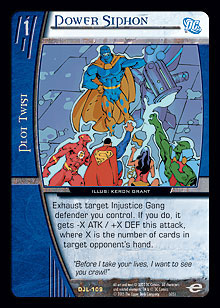 Power Siphon was created for a placeholder originally called “Reinforcement Hoser.” During a plotline in the comics, Libra captured the JLA when he formed his incarnation of the Injustice Gang in order to siphon their powers for himself. It made a good name for a card that killed reinforcements. The notion evolved into a card that sucked the energy right out of your opponent’s hand and into your defender’s DEF, which also reflected the name.
Power Siphon was created for a placeholder originally called “Reinforcement Hoser.” During a plotline in the comics, Libra captured the JLA when he formed his incarnation of the Injustice Gang in order to siphon their powers for himself. It made a good name for a card that killed reinforcements. The notion evolved into a card that sucked the energy right out of your opponent’s hand and into your defender’s DEF, which also reflected the name.
It’s not enough to just read random comics to come up with ideas, however. Sometimes you have to do some specific research, and focus your efforts more carefully. While three of the four teams were pretty straightforward, we had our work cut out for us with the Secret Society of Super-Villains—a very cool team, but one limited mainly to its own, short-lived title in the late 1970’s (and those issues are not easy to find). They had appeared in two other incarnations as well, but those were even more short-lived, and the remainder of their appearances were scattered across a handful of comics in the 80’s. In addition, there were so many members on the team that its original list was longer than each of the other teams’ preliminary rosters (including characters like Rag Doll, Signalman, Riddler, and Reverse-Flash—plus a couple of characters like Shadow-Thief, who transferred over to the Injustice Gang). Hunting them down and compiling them into a viable list took some real doing.
After finding a treasure trove Internet site for the Secret Society—complete with a ton of issue synopses to fill in the issues I was missing—one character stood out above all others: Lex Luthor. His “membership” was brief, but integral to the storyline—and you can never have too many Lexes! He was the main suggestion for the SSOSV in the first pass.
The Secret Society also had a nearly empty sheet for non-character cards—with only Sinister Citadel, Slaughter Swamp, and a placeholder for an attack-bonus card—so I had to come up a string of suggestions for card names. As always, some made it into the final set, and some didn’t.
Since the Society needed more locations, Gorilla City seemed like a no-brainer: the City made a brief appearance in the comic and Gorilla Grodd was central to the team. Mysterious Benefactor reflected the Secret Society’s hidden supporters—most notably Darkseid, but also the Wizard, each of whom used the Society to further his own ends. Attend or Die! came from the invitation the original Society members received, which read, “You are cordially invited to attend the first bi-monthly meeting of the Secret Society of Super-Villains . . . Attend or Die!”
Sorcerer’s Treasure was one of the main storylines of the comic, and was the Wizard’s main reason for putting his version of the team together (which is why he’s on the card). It consisted of four “treasures”—the Energy Prism, the Dragon Box, the Power Glove (which always makes me think of Fred Savage in The Wizard), and the Cloak of Invisibility. It was also suggested that they could be used individually as equipment cards, in addition to (or instead of) the single plot twist.
The Quadromobile was used by Gorilla Grodd to break several members out of prison, and was good for bank robbing. Besides, it looks so cool!
Funky’s Big Rat Code—which is one of the coolest card names ever—was a code created by Funky Flashman to pass info between members. The code itself was only ever revealed on the letters page of a single issue (#9). If you always wondered what the card said, the code can be found here.
Other interesting factoids about the original preliminary set list:
—The designers originally planned a fifth team, the Extremists, but it was cut to add more room for generics and to fill out the other teams. Justice League Antarctica was a suggestion to replace it (or at least to become a plot twist, with maybe G’Nort and the Scarlet Skier on the art). Alas, Matt had too much common sense to fall prey to that suggestion, so we’ll just have to wait on it.
—The unaffiliated list was about twice as long as the final roster—which is not uncommon for Vs. sets. We always have more character and card names than we need. They’re trimmed down as the set gets closer to its final phase. Characters like Amos Fortune and the Shaggy Man get cut—and they’re often painful, necessary though they may be. (Much to my chagrin, pleas for a Paragon card fell on deaf ears. He can mimic the powers of everyone within range, and use them better than the true holders could! And his costume was hella 80’s! Oh well . . .)
Legacy content tends to be the last piece of the set puzzle to be completed, but researchers always have it in the backs of their minds from the initial research onwards—it is important to make sure that the Legacy content reflects the theme of the overall set as much as possible.
A few Legacy ideas made it into the first pass. The primary suggestion was for a Green Lantern Ollie Queen and Flash—namely because both were so close to Hal Jordan, and shared a comic with him as well. (Green Arrow was in Green Lantern for ages, and Green Lantern—originally with Green Arrow—had back-up stories in The Flash when the GL title was canceled for a while in the early 70’s.) I also knew that people were dying to see Ollie and Barry in the set, and that giving them an extra version of each would be happy times. (Luckily, Ollie did get a second version on the GL team.)
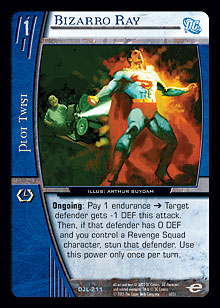 I thought the Bizarro Ray would be hilariously fun to create as a card—the ray that creates Bizarro versions of people! Every Revenge Squad needs one!
I thought the Bizarro Ray would be hilariously fun to create as a card—the ray that creates Bizarro versions of people! Every Revenge Squad needs one!
The concept of the Mobius Chair was one of the rare times when I suggested a design concept —something that researchers nearly never do. We have no part in the design process, and for good reason: most researchers are as partisan as any other comic fan, and if we had our way the game would 1) be chaotic, 2) have no balance, and 3) certain cards would win the game by their mere existence! In this case, Mobius Chair was suggested as a New Gods equipment card, a unique flight-gainer with some über-power to show how Metron traveled through space and time with it. In the end, it became a unique equipment card that granted flight and +1 DEF. You could KO it to move a 3-cost or higher New Gods character to the hidden or visible area—a beautiful rendition of its travel powers.
The idea for Die for Darkseid!’s name came while reading through the JLI run where Big Barda leads Rocket Red, G’Nort, and the Martian Manhunter to Apokolips to rescue Mister Miracle from Manga Khan. The walls of the buildings were lined with posters with Darkseid’s image in an Uncle Sam-style pose, with “Die for Darkseid!” written on them. It seemed like a great card name.
Some other legacy ideas didn’t make it through:
—An Eclipso for the Emerald Enemies. He was such a major Green Lantern villain that he deserved some recognition for it. Hopefully, we’ll see his card someday.
—Majestic for Team Superman. Although I’m not sure how the Wildstorm license works—whether or not he’s allowed into a DC set—his interaction with Superman in his first DC mini-series (which was fairly new around the time we were working on the set) would have made an interesting segue into the Wildstorm Universe. The funny thing is that I didn’t have any idea about dual affiliation—I had nothing to do with set design—and so I had no idea that Dr. Fate would be previewing the Shadowpact team affiliation. It would have been über-cool to have included a dual-affiliated Majestic in the legacy Team Superman, but also with Wildcats.
—Mia ◊ Speedy was the initial recommendation for Teen Titans legacy content. The storyline when she joins the Titans is great, and Roy Harper needs some fellow archer-types. Hopefully she’ll make it onto the team someday.
JLA: The Second Pass
By the time the second pass came around, it was just a matter of trimming the fat and making sure the team rosters were tightened. Matt sent me a revised set list and asked me to suggest who to keep, who to drop, and whether anything had been overlooked.
This part of the process is less research-heavy, and relies mainly on the researcher’s latent comic knowledge and creativity. We don’t have time to read comics forever, and we have to put most of our efforts into melding thematic content with the Rosters and brainstorming for as many name ideas as possible.
For the JLA team, Matt wanted to keep some lower drops, and that meant choosing between Snapper and Triumph. If he was going to need one of them, Snapper was the obvious choice, being more relevant to the JLA historically than Triumph was. Also, at that point, Aquaman had three versions, since he had never been in a set before and the likelihood of him ever being able to have his own set was miniscule. But with such a massive roster, three separate versions were simply too many. Big Barda, the second Plastic Man, and John Stewart were cut suggestions—the last because he simply wasn’t an essential JLA’er. Matt had decided against including the various first pass suggestions for JLA (Gypsy would come much later), so I repeated a suggestion for Vixen and the Phantom Stranger, who were particularly important members, and left the rest aside. Vixen remained on the set roster until fairly late in the process, when she was replaced by Gypsy.
The JLI team was coming along—except that most of the founders were missing! JLA had two Martian Manhunters, but JLI didn’t have a single one (which Matt would eventually resolve by putting a dual-affiliated version on each team). And there was no Batman, Wonder Woman, or Black Canary! I also wanted to see a G’Nort, but alas, it was not to be—especially on the heels of a Green Lantern set. Sue Dibny seemed superfluous as a member, since she never truly belonged to the team, but she was kept, both because of a need for lots of low drops and possibly because of Identity Crisis. Lightray and Orion had to go; although they were kinda sorta affiliated with the JLI, they were really only there for their own purposes and left when their mission was complete. And Huntress, who was forced into joining and later expelled, simply wasn’t as important as a lot of other characters. In the end, Wonder Woman was too integral to the JLA and never saw a JLI version. Matt wanted a fair number of low drops as well, so Catherine Cobert and Sue stayed. In retrospect, I’m happy they were kept—their comic flavor was great—but I’m also happy that Batman, Black Canary, and especially J’onn J’onzz got versions as well.
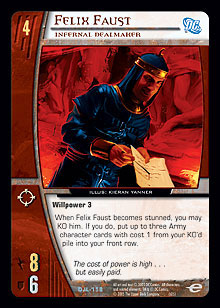 For the Secret Society, it made sense for them to remain as true as possible to the original version in the comics, which would allow us to ignore any connection to the later versions and free up more slots for characters and alternate versions. In the end, Matt didn’t go that way, so the set featured a mixture of characters from the various incarnations over the years. In that case, why not add Professor Zoom, Monocle and Cheetah, who were all key members of the later teams? No go. However, many of the existing characters on the roster needed to go—Shadow-Thief, for example, was only in one issue and never reappeared on the team, so it didn’t make sense for him to be there (he was shifted to the Injustice Gang). The same could be said for Felix Faust, who was moved to the unaffiliated bracket. A few other, similar characters had to go, and Matt agreed with most deletions
For the Secret Society, it made sense for them to remain as true as possible to the original version in the comics, which would allow us to ignore any connection to the later versions and free up more slots for characters and alternate versions. In the end, Matt didn’t go that way, so the set featured a mixture of characters from the various incarnations over the years. In that case, why not add Professor Zoom, Monocle and Cheetah, who were all key members of the later teams? No go. However, many of the existing characters on the roster needed to go—Shadow-Thief, for example, was only in one issue and never reappeared on the team, so it didn’t make sense for him to be there (he was shifted to the Injustice Gang). The same could be said for Felix Faust, who was moved to the unaffiliated bracket. A few other, similar characters had to go, and Matt agreed with most deletions
Researchers are never infallible, however, and not all of our suggestions are good ones. Sometimes we make mistakes in our decisions, and we’re fortunate that most of them are caught. My biggest error in judgment for this team (and for the set) was suggesting that Darkseid be dropped. I figured that since he never really joined the team—or even fought with them—that he shouldn’t be a part of them. He used them for his own purposes, as a replacement for his Inter-Gang (not to be confused with the Intergang of Lex Luthor’s Revenge Squad), and the team turned against his “mysterious” leadership thanks to his agent: the clone of Manhunter Paul Kirk. In retrospect, Matt made the right call on this one—he had to be on the team!
One final suggestion from this pass was for an unaffiliated Captain Comet—the hero who was tricked into believing the Secret Society was a force for good and fought alongside them very briefly. He was never really considered, but he would make a very cool Vs. character!
JLA: The Third Pass
At this point, the set list was almost complete. With the help of UDE’s resident DC expert, Kevin Tewart, Matt had solidified the rosters and we were now focusing on plot twists and similar cards. For the characters, Matt was on the verge of dropping Faith, Zauriel, and a 2-drop Batman he had planned, in exchange for Vixen, Steel II, and Gypsy. In the end, Faith and Zauriel stayed, and Gypsy was the only JLA Detroit character to make the cut. They also decided to save the Phantom Stranger for the next DC set, which at the time had a magic-based theme. (The concept would eventually be replaced by Infinite Crisis—although the Shadowpact are magic-based, so who knows? Maybe I’ll get my Phantom Stranger after all . . . We’ll have to wait and see!)
And on to the non-characters. Numerous files went back and forth as I brainstormed dozens of card names. I like to use the titles of major storylines as cards—not only are they usually pretty cool, but they bring recognition to fans and comic geeks like me, and can potentially attract new people to the game. They also open the cards up to the themes of the set, and create a lot of flavor in terms of game play. That’s why “Superman’s Funeral” was changed to Funeral for a Friend in the third pass, since that was the name of the issue where Superman’s funeral takes place. Other storyline names that came up in this final brainstorm were “A Midsummer’s Nightmare,” “A New Beginning,” “Act of God,” “Heaven’s Ladder,” “Rock of Ages,” “Divided We Fall,” “Gorilla Warfare,” and several others.
Membership Drive also sprouted from this pass, as it was a common theme to JLA comics—though the card eventually shifted to the generics. One of my favorite storylines, World War III, was suggested for the Injustice Gang and made it into the set.
And this pass included my personal favorite suggestion:
“Oreos and Milk/Late Night Snack/Midnight Snack – Martian Manhunter has a bizarre obsession with Oreos and milk. It would be awesome to include a card to reflect that.”
It became Midnight Cravings, which includes one of the best images in the entire Vs. System.
My favorite idea that didn’t get used was “Oberon Unleashed,” the title for JLI #22, where Oberon deals with Khundian invaders by donning camo gear and attacking the Khunds with Blue Beetle’s High-Tech Flare Gun!
The final wave of ideas went back and forth between myself and Matt, and he chose what he liked, and filled in the remaining blanks on his end. Eventually, it was time to push the next step into high gear: the art had to be designed and sent to the artists!
NEXT: The process of designing and requesting art for the JLA set.
AND THEN: A different side to researching for a set as the process begins anew for X-Men!
Questions? Queries? Comments? Send ’em along and I’ll try to get them answered in the column! Email me at:
Kergillian@hotmail.com
Also known by his screen name Kergillian, Ben Kalman has been involved in the Vs. community since day one. He started the first major online community, the Vs. Listserv, through Yahoo! Groups, and it now boasts well over 1,850 members! For more on the Yahoo! group, go to http://groups.yahoo.com/group/Marvel_DC_TCG.